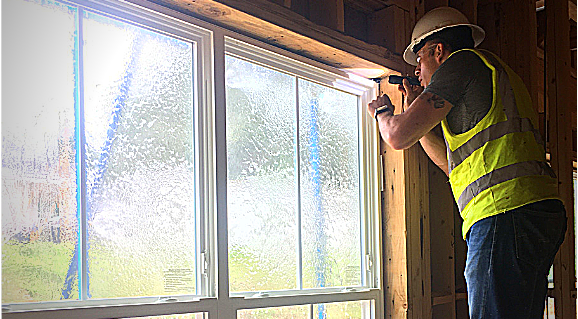
Power washing can make your home’s exterior look like new — but if done incorrectly, it can also force water into places it shouldn’t go. Many homeowners are surprised to discover water leaks, wet walls, or even interior mold after a DIY power wash. So, one of the most important questions to ask is: How do I avoid water infiltration into the house while power washing?
The good news is, with the right techniques and precautions, you can prevent water from sneaking inside and keep your power washing project both safe and effective. 🚫💦
🧱 What Causes Water Infiltration During Power Washing?
Water infiltration happens when high-pressure water finds a way behind your siding, under your roofline, or through windows and doors. Common entry points include:
- 🪟 Window seals
- 🚪 Door frames
- 🧱 Siding gaps or cracks
- 🪜 Roof flashing and soffits
- 🧯 Vents, outlets, and light fixtures
When water enters through these openings, it can soak insulation, damage drywall, and lead to mold or rot inside your walls. 😬
🚿 Rule #1: Don’t Use Excessive Pressure
The biggest mistake homeowners make is assuming that more pressure equals better cleaning. In reality:
- 1,200 to 2,000 PSI is plenty for most siding jobs
- Anything above 2,500 PSI increases the risk of water intrusion
- Even moderate pressure can force water behind siding if aimed the wrong way
💡 Use the lowest pressure necessary to get the job done — especially near doors, windows, or trim.
🧼 Use the Right Spray Angle
This is one of the most critical tips:
✅ Spray at a downward or horizontal angle, never upward.
Spraying upward can force water under siding panels, into attic vents, or behind window flashing. Always:
- Stand slightly above or level with the area you’re cleaning
- Keep the nozzle angled parallel or downward
- Use smooth, sweeping motions — don’t linger in one spot
Think of your spray like a rainstorm — you want water to wash down, not up. 🌧️⬇️
🪟 Seal Gaps and Cracks First
Before you even pull the trigger, do a full walkaround of your home. Look for:
- Cracked or missing caulk around windows and doors
- Loose siding or trim pieces
- Damaged seals around utility boxes or vents
- Gaps between your foundation and siding
🧰 Use exterior-grade caulk or sealant to patch these areas. It’s a quick fix that can save you hundreds in water damage repairs.
🔌 Cover Sensitive Areas
Certain home components should be protected before spraying, including:
- Electrical outlets and boxes ⚡
- Doorbells and smart cameras 🛎️
- Dryer vents and soffit vents 🌀
- Light fixtures 💡
Use plastic sheeting, tape, or waterproof covers to block off these areas. Then remove the covers once the job is done and surfaces are dry.
🧴 Apply Detergent the Right Way
Don’t blast detergent at full force. Instead:
- Pre-wet the surface with a low-pressure setting
- Apply detergent using a soap tip or foam cannon
- Let it dwell for 5–10 minutes
- Rinse with a wide spray tip (25° or 40°) at moderate pressure
This approach gets surfaces clean without having to blast grime out of cracks — reducing your risk of water penetration.
Browse Amazon Here For Popular Power Washing Detergents
🧠 Be Extra Careful Around:
- 🪟 Windows: Spray from the sides or top down, never from underneath
- 🚪 Doors: Avoid spraying directly into the base or trim
- 🏠 Soffits and eaves: Use low pressure and keep the spray horizontal
- 🌪️ Attic vents: These often open directly into unsealed spaces
If in doubt, clean these areas manually with a hose and brush or opt for soft washing instead.
💧 Watch for Warning Signs of Water Intrusion
During or after power washing, look out for:
- Wet patches on interior walls
- Dripping water from window or door frames
- Fogging between window panes
- Water pooling at the base of walls or doors
If you notice any of these, stop washing immediately and investigate. Quick action can prevent long-term damage. 🧯
🧰 Tools That Help Prevent Water Infiltration
- Extension wands: Allow better control from a safe distance
- Rotating surface cleaners: Great for decks and sidewalks — keeps spray contained
- Foam cannons: Apply detergent gently without splashing into cracks
- Lower PSI electric pressure washers: Less risky for siding and trim
Sometimes it’s the tools — not just the technique — that make all the difference. 🛠️
🏁 Final Thoughts
So, how do you avoid water infiltration while power washing your house?
- ✅ Use low to moderate pressure
- ✅ Spray downward, not upward
- ✅ Seal all gaps and cracks before you begin
- ✅ Protect sensitive openings like vents, lights, and outlets
- ✅ Use detergent and rinsing techniques that limit water intrusion
With the right prep and smart execution, you can enjoy a cleaner home exterior without the risk of indoor headaches. 🧼🏠💧
Browse Amazon Here For Top Rated Power Washers And Accessories






